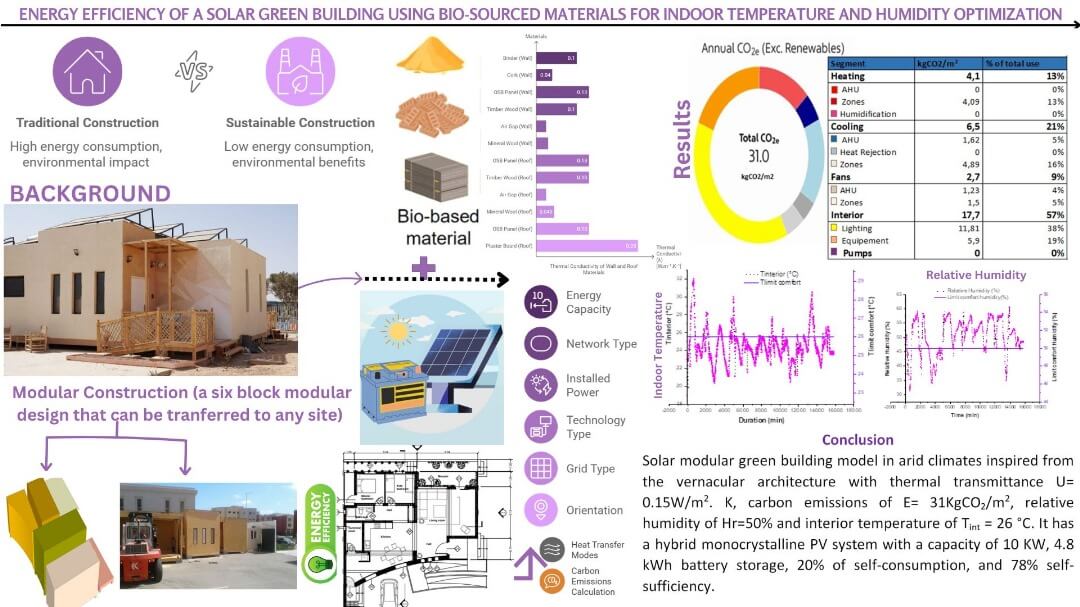 Open Access
Open Access
ARTICLE
Energy Efficiency of a Solar Green Building Using Bio-Sourced Materials for Indoor Temperature and Humidity Optimization
1 National School of Architecture Agadir, New Complex Ibn Zohr, Agadir, BP 20732, Morocco
2 EMDD, CERNE2D, University of Mohammed V in Rabat, Est Sale, Sale, BP 227, Morocco
3 Thermodynamics and Energetics Laboratory, Faculty of Science, Ibn Zohr University, Agadir, BP 8106, Morocco
4 Faculty of Built Environment, University Sains Islam Malaysia, Nilai, BP 71800, Malaysia
5 Architectural Engineering Department, Najran University, Najran, BP 1988, Saudi Arabia
6 The Centre of Scientific and Engineering Research, Najran University, Najran, BP 1988, Saudi Arabia
7 Euro-Mediterranean School of Architecture, Design and Urbanism, Euro-Mediterranean University of Fez, Fez, BP 51, Morocco
* Corresponding Author: Soumia Mounir. Email:
(This article belongs to the Special Issue: Materials and Energy an Updated Image for 2023)
Energy Engineering 2025, 122(1), 41-62. https://doi.org/10.32604/ee.2024.057125
Received 08 August 2024; Accepted 11 November 2024; Issue published 27 December 2024
Abstract
A clean environment with low carbon emissions is the goal of research on the development of green and sustainable buildings that use bio-sourced materials in conjunction with solar energy to create more sustainable cities. This is particularly true in Africa, where there aren’t many studies on the topic. The current study suggests a 90 m2 model of a sustainable building in a dry climate that is movable to address the issue of housing in remote areas, ensures comfort in harsh weather conditions, uses solar renewable resources—which are plentiful in Africa—uses bio-sourced materials, and examines how these materials relate to temperature and humidity control while emitting minimal carbon emissions. In order to solve the topic under consideration, the work is split into two sections: numerical and experimental approaches. Using TRNSYS and Revit, the suggested prototype building is examined numerically to examine the impact of orientation, envelope composition made of bio-sourced materials, and carbon emissions. Through a hygrothermal investigation, experiments are conducted to evaluate this prototype’s effectiveness. Furthermore, an examination of the photovoltaic system’s production, consumption, and several scenarios used to maximize battery life is included in the paper. Because the biosourced material achieves a thermal transmittance of 0.15 (W.m−2.K−1), the results demonstrate an intriguing finding in terms of comfort. This value satisfies the requirements of passive building, energy autonomy of the dwelling, and injection in-network with an annual value of 15,757 kWh. Additionally, compared to the literature, the heating needs ratio is 6.38 (kWh/m2.an) and the cooling needs ratio is 49 (kWh/m2.an), both of which are good values. According to international norms, the inside temperature doesn’t go above 26°C, and the humidity level is within a comfortable range.Graphic Abstract

Keywords
Cite This Article
 Copyright © 2025 The Author(s). Published by Tech Science Press.
Copyright © 2025 The Author(s). Published by Tech Science Press.This work is licensed under a Creative Commons Attribution 4.0 International License , which permits unrestricted use, distribution, and reproduction in any medium, provided the original work is properly cited.


 Submit a Paper
Submit a Paper Propose a Special lssue
Propose a Special lssue View Full Text
View Full Text Download PDF
Download PDF Downloads
Downloads
 Citation Tools
Citation Tools
